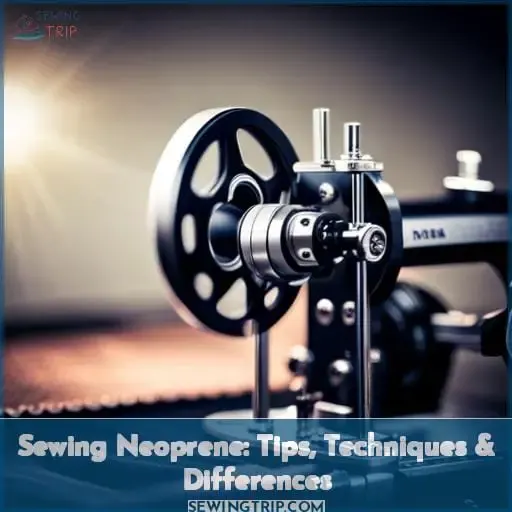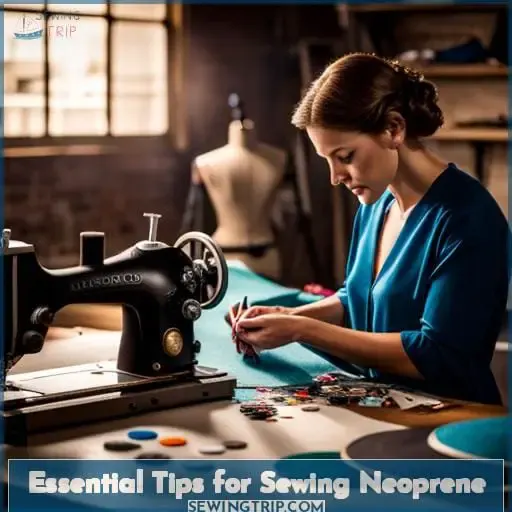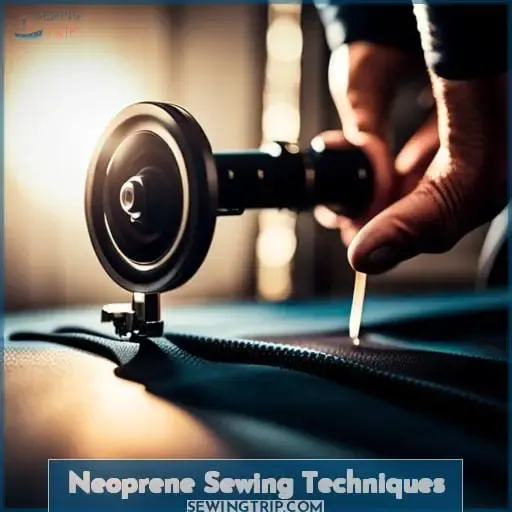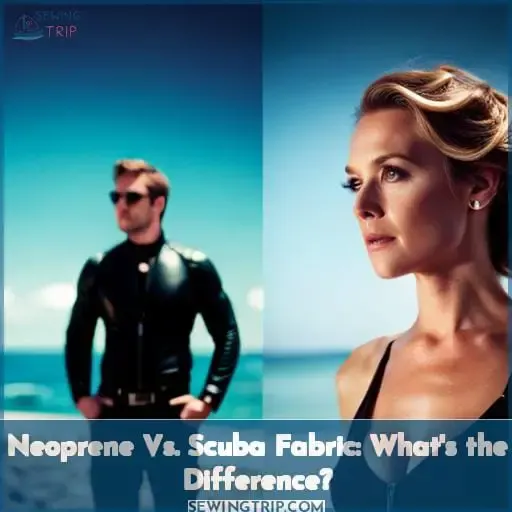This site is supported by our readers. We may earn a commission, at no cost to you, if you purchase through links.
 Are you ready to tackle neoprene sewing? If so, you’ve come to the right place. Sewing with neoprene is no easy feat; it’s a fabric that requires extra care and special techniques for success.
Are you ready to tackle neoprene sewing? If so, you’ve come to the right place. Sewing with neoprene is no easy feat; it’s a fabric that requires extra care and special techniques for success.
In this article, we’ll cover essential tips for how to sew neoprene fabrics, various techniques as well as the difference between neoprene and scuba fabrics.
So grab those needles and let’s begin our journey through learning how to sew one of fashion’s most unique materials – Neoprenes! First, we’ll go over some key differences between neoprene and scuba knit fabrics so you know what you’re working with.
Neoprene has more stretch and rebound than scuba knit. It’s also thicker, warmer, and more water resistant given its origins as wetsuit material. Scuba knit is a lighter weight knit fabric that drapes better for garments. Both can work for apparel and gear, but neoprene’s properties make it better suited for items where warmth and buoyancy matter.
When sewing neoprene, use a leather or denim needle size 90/14 and polyester thread. Avoid cotton thread as it will not have the strength needed for stretchy neoprene seams. Set your machine to a longer stitch length, around 3 mm to allow room for the material to stretch without popping stitches.
A walking or dual feed foot is also helpful for managing the thick, grippy fabric.
Mark all pattern pieces on the smooth side of the neoprene, not the textured side. Use washable marker in case of any ink bleeding. Be sure to leave ample seam allowances too – 1/2 to 5/8” is a good minimum.
When stitching seams, use a zigzag or overlock stitch for stretch. Follow up with a second topstitch row next to the seam for reinforcement. Go slow and steady as you sew to avoid skipped stitches in the thick material. Binding edges with bias tape will also add comfort and durability.
If you need to topstitch or decorate neoprene, use a Teflon presser foot and place tissue paper underneath to avoid any melted texture from adhering.
Take your time, watch tension, and use the right tools – these tips will have you sewing neoprene masterfully in no time.
Table Of Contents
Key Takeaways
- Use a size 90/14 leather or denim needle and polyester thread when sewing neoprene. Vary the stitch length and utilize a zigzag or overlock stitch to accommodate the stretchiness.
- Consider employing a walking or dual feed foot as well as a Teflon presser foot to enable smooth sewing.
- Mark the pattern pieces on the smooth side, allow ample seam allowances, and leave the raw edges exposed.
Essential Tips for Sewing Neoprene
Sewing with neoprene, while challenging, will reward the crafty sewer with professional-looking garments. Laying out a plan to select the best stitch, add zippers, manage raw edges, and adjust commercial patterns are the keys to successfully working with this unique material.
Some essential tips for sewing neoprene include choosing the right needle and thread, using interfacing, managing seam allowances, and making adjustments to patterns designed for woven fabrics. A leather needle easily penetrates the spongy neoprene, while polyester thread handles the stretch.
Interfacing stabilizes seams and raw edges. Allowing 1/2 seam allowances gives the stretchy fabric room to feed through the machine. And patterns may need adjusting at curves and openings to account for the difference between woven and knit fabrics.
With preparation and practice, sewers will find neoprene an exciting material for fashionable and functional creations.
Choosing the Right Stitch
You’ll find that a wide regular zigzag stitch with lower tension is ideal for sewing neoprene. Opt for a stretch stitch like zigzag over straight on this flexible material. Adjusting stitch length and width gives decorative options for finishing edges.
Play with tension so stitches don’t pucker; a walking foot provides even feeding. Don’t limit yourself to basics – experiment with stitches to find what works on different neoprene thicknesses.
Adding Zippers to Neoprene
When integrating zippers into neoprene garments, go with metal or nylon coil options over plastic since the fabric’s thickness demands greater durability.
- Choose between lapped, centered, or invisible zipper placement based on the garment design.
- Opt for metal teeth or nylon coil zippers rather than plastic ones.
- Use a Teflon zipper foot and topstitch for a clean finish.
- Finish seam allowances with zigzag or serger stitching.
- Mind the needle heat and bulk when installing zippers.
Avoid visible topstitching on neoprene by pressing seams open or using a hidden zipper foot. The motorized walking foot mechanism on your machine’ll help feed the thick fabric smoothly. With the right tools and technique, it’s easy to add durable zippers to neoprene accessories.
Dealing With Raw Edges
Neoprene’s durability lets you go raw. Avoid finishing edges on this rugged fabric. Simply cut pieces precisely and butt seam allowances together, fusing them with adhesive seam sealant. For clean edges, apply binding tape or fold narrow hems, securing them with zigzag stitching.
With neoprene’s forgiving nature, raw edges offer flexibility in design. Embrace the material’s rawness in your unique creations.
Working With Commercial Patterns
While commercial patterns call for seam allowances, skipping them when working with neoprene will give clean edges that stretch without fraying. When sewing neoprene accessories from a commercial pattern, focus on fabric selection and sizing adjustments rather than seam finishes.
Opt for a flexible neoprene, size down to prevent sagging, and skip seam allowances. With the right supplies, like a walking foot machine, you’ll have the power to customize any pattern for this liberating fabric.
Neoprene Sewing Techniques
Making magic in neoprene requires some special techniques. Select a zigzag stitch to join seams. Lower the tension, lengthen the stitch length and you’ll glide through the material effortlessly. Raw edges fuse when pressed together. Simply lay them flat and zigzag over the join.
There’s no need for pins or seam allowances. Modify your patterns as needed, combining smaller pieces to avoid creases.
Unlike scuba knits, neoprene’s bulky. Embrace the thickness and make it work for you. With the right needle and foot, and lower tension, you’ll have the flexibility and comfort of scuba with neoprene’s structure.
Take charge of this modern material and craft unique creations that make a bold statement.
Neoprene Vs. Scuba Fabric: What’s the Difference?
You’d be swimming in options when deciding between neoprene’s insulating stretch or scuba’s lighter flexibility for your aquatic adventures. Neoprene wins for thermal protection with its stretchy, wetsuit-like warmth that cocoons you in cozy comfort.
Scuba flows with a featherweight fluidity, its four-way stretch bending to your body’s curves. Neoprene’s thick resilience shrugs off fraying edges when you slice patterns with your rotary cutter. Scuba’s thinner skin needs more delicate care. Crank your sewing machine‘s speed for neoprene’s sturdy construction.
Consider your priorities – do you need insulation or flexibility? Then dive into neoprene’s insulating embrace or scuba’s lightweight flow.
Embroidering on Neoprene: Tips and Tricks
Now that you understand the differences between neoprene and scuba fabrics, it’s time to dive into embroidering on neoprene! As a versatile synthetic rubber fabric, neoprene offers exciting possibilities for custom embroidered creations.
Here are four key tips to embroider successfully on neoprene:
- Stabilizer selection is critical. Use water-soluble stabilizer on top and cutaway stabilizer underneath for the best results.
- Expect potential difficulties around intricate designs and dense stitching. Adjust and simplify patterns accordingly.
- Specialty embroidery tools like washaway topping, ballpoint needles, and adhesive spray can be extremely helpful when working with neoprene’s temperamental nature.
- Consider design size and placement carefully. Hoop only the stabilizer, then lay neoprene flat on top to prevent distortion.
Experiment and let your creative spirit soar as you transform neoprene into one-of-a-kind embroidered fashions and accessories! The versatility of this fabric empowers your wildest visions.
Conclusion
Sewing with neoprene can be intimidating, but with the right tips and techniques, you can create beautiful garments and accessories. From using the proper needle and adjusting thread tension correctly to mastering the art of adding zippers, you can sew neoprene with confidence.
Understanding the difference between neoprene and scuba fabric can also help you choose the right material for your project. It is essential to comprehend the nuances of each fabric to ensure you make a piece that meets your needs and expectations.










